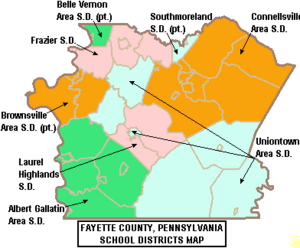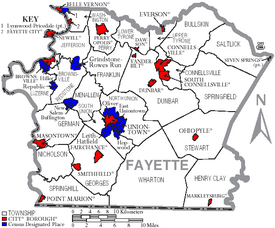Fayette County, Pennsylvania facts for kids
Quick facts for kids
Fayette County
|
|||||
|---|---|---|---|---|---|
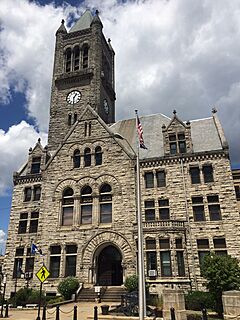
Fayette County Courthouse
|
|||||
|
|||||
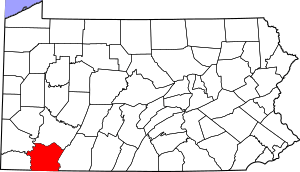
Location within the U.S. state of Pennsylvania
|
|||||
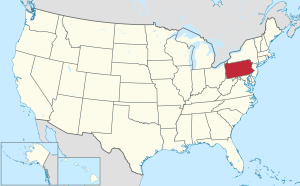 Pennsylvania's location within the U.S. |
|||||
| Country | |||||
| State | |||||
| Founded | September 26, 1783 | ||||
| Named for | Marquis de Lafayette | ||||
| Seat | Uniontown | ||||
| Largest city | Uniontown | ||||
| Area | |||||
| • Total | 798 sq mi (2,070 km2) | ||||
| • Land | 790 sq mi (2,000 km2) | ||||
| • Water | 8.0 sq mi (21 km2) 1.0%% | ||||
| Population
(2020)
|
|||||
| • Total | 128,804 | ||||
| • Density | 163/sq mi (63/km2) | ||||
| Time zone | UTC−5 (Eastern) | ||||
| • Summer (DST) | UTC−4 (EDT) | ||||
| Congressional district | 14th | ||||
Fayette County is a county in the state of Pennsylvania. It is located in the southwestern part of Pennsylvania. This county is next to Maryland and West Virginia. In 2020, about 128,804 people lived here.
The main town, or county seat, is Uniontown. Fayette County was created on September 26, 1783. It was formed from a part of Westmoreland County. The county was named after the Marquis de Lafayette. He was a French hero who helped America in the Revolutionary War. Fayette County is part of the Southwest Pennsylvania region. It is also part of the larger Pittsburgh area. The southern border of Fayette County is also the southern border of Pennsylvania. This includes the famous Mason–Dixon line.
Contents
History of Fayette County
The first Europeans came to Fayette County a long time ago. They used old trails made by Native Americans. These trails crossed the county. In 1754, France and Great Britain were fighting over this land. A young George Washington, who was 22, fought the French here. This was at the Battle of Jumonville Glen and Fort Necessity.
British forces, led by Washington and General Edward Braddock, made the roads better. This made Fayette County an important path for supplies.
During the Revolutionary War, Fayette County faced attacks. These attacks came from Native Americans who sided with the British. The area was also far from other settlements. There was also a disagreement with Virginia about the border. In 1780, the government decided the land belonged to Pennsylvania. So, Fayette County was formed in 1783.
Fayette County farmers tested the new U.S. government in 1793. This was during the Whiskey Rebellion. Farmers protested a new tax on liquor. President George Washington sent militias to restore order. But, Albert Gallatin, who owned Friendship Hill, helped avoid violence. Fayette County stayed important for travelers in the early 1800s. The National Road helped settlers move west through the mountains. Shipyards in Brownsville built ships for trade.
As Pittsburgh grew its industries, Fayette County became a center for coal mining. It also produced coke, which is used to make steel. From the 1880s to the early 1900s, steel production grew a lot. This made the area very important for the country. Labor unions also became very strong here. Many new immigrants from Europe came for jobs. Also, African Americans moved here from the South during the Great Migration. They came for factory jobs.
By World War II, workers in Fayette County had better jobs and lives. But in the 1950s, the coal industry started to decline. In the 1970s, the steel industry also struggled. This caused many jobs to be lost. The population has gone down since 1940. Many people had to move to find work. Today, only a few mines are still open. But natural resources are still key to the local economy. The area is now moving towards service jobs, like telemarketing.
Geography and Natural Features
Fayette County covers about 798 square miles. Most of this is land, with about 8 square miles of water. The western part of the county has rolling hills. It also has two valleys along the Monongahela and Youghiogheny rivers. The eastern part of the county has many mountains and forests. Many coal mines are found here. Fayette County is part of the "Greater Appalachia" region.
Neighboring Counties
Fayette County shares borders with these counties:
- Westmoreland County (north)
- Somerset County (east)
- Garrett County, Maryland (southeast)
- Preston County, West Virginia (south)
- Monongalia County, West Virginia (southwest)
- Greene County (west)
- Washington County (northwest)
Protected Natural Areas
- Fort Necessity National Battlefield: This is a historic site where George Washington fought.
- Friendship Hill National Historic Site: This is the home of Albert Gallatin, an important early American leader.
Climate and Weather
Fayette County has a humid continental climate. This means it has warm summers and cold winters.
| Climate data for Uniontown, Pennsylvania (1981-2010; Extremes 1974–present) | |||||||||||||
|---|---|---|---|---|---|---|---|---|---|---|---|---|---|
| Month | Jan | Feb | Mar | Apr | May | Jun | Jul | Aug | Sep | Oct | Nov | Dec | Year |
| Record high °F (°C) | 79 (26) |
77 (25) |
88 (31) |
93 (34) |
93 (34) |
97 (36) |
102 (39) |
102 (39) |
99 (37) |
95 (35) |
88 (31) |
77 (25) |
102 (39) |
| Mean daily maximum °F (°C) | 39 (4) |
43 (6) |
51 (11) |
63 (17) |
72 (22) |
81 (27) |
84 (29) |
83 (28) |
76 (24) |
65 (18) |
54 (12) |
43 (6) |
63 (17) |
| Mean daily minimum °F (°C) | 20 (−7) |
22 (−6) |
28 (−2) |
37 (3) |
46 (8) |
56 (13) |
60 (16) |
59 (15) |
51 (11) |
40 (4) |
32 (0) |
24 (−4) |
40 (4) |
| Record low °F (°C) | −22 (−30) |
−16 (−27) |
−3 (−19) |
15 (−9) |
23 (−5) |
33 (1) |
37 (3) |
34 (1) |
29 (−2) |
16 (−9) |
−1 (−18) |
−14 (−26) |
−22 (−30) |
| Average precipitation inches (mm) | 2.8 (71) |
2.7 (69) |
3.8 (97) |
4.0 (100) |
4.4 (110) |
4.3 (110) |
4.8 (120) |
3.9 (99) |
3.6 (91) |
2.9 (74) |
3.5 (89) |
3.2 (81) |
43.9 (1,111) |
| Average snowfall inches (cm) | 8.4 (21) |
7.2 (18) |
4.6 (12) |
0.4 (1.0) |
0.0 (0.0) |
0.0 (0.0) |
0.0 (0.0) |
0.0 (0.0) |
0.0 (0.0) |
0.0 (0.0) |
0.9 (2.3) |
4.4 (11) |
25.9 (65.3) |
Population and People
| Historical population | |||
|---|---|---|---|
| Census | Pop. | %± | |
| 1790 | 13,318 | — | |
| 1800 | 20,159 | 51.4% | |
| 1810 | 24,714 | 22.6% | |
| 1820 | 27,285 | 10.4% | |
| 1830 | 29,172 | 6.9% | |
| 1840 | 33,574 | 15.1% | |
| 1850 | 39,112 | 16.5% | |
| 1860 | 39,909 | 2.0% | |
| 1870 | 43,284 | 8.5% | |
| 1880 | 58,842 | 35.9% | |
| 1890 | 80,006 | 36.0% | |
| 1900 | 110,412 | 38.0% | |
| 1910 | 167,449 | 51.7% | |
| 1920 | 188,104 | 12.3% | |
| 1930 | 198,542 | 5.5% | |
| 1940 | 200,999 | 1.2% | |
| 1950 | 189,899 | −5.5% | |
| 1960 | 169,340 | −10.8% | |
| 1970 | 154,667 | −8.7% | |
| 1980 | 159,417 | 3.1% | |
| 1990 | 145,351 | −8.8% | |
| 2000 | 148,645 | 2.3% | |
| 2010 | 136,606 | −8.1% | |
| 2020 | 128,804 | −5.7% | |
In 2010, there were 136,606 people living in Fayette County. About 93.3% of the people were White. About 4.7% were Black or African American. The average household had 2.43 people. The average family had 2.96 people.
About 22.7% of the population was under 18 years old. About 18.1% were 65 years or older. The average age was 40 years. For every 100 females, there were about 91.8 males.
Education and Learning
Colleges and Universities
- Penn State Fayette, The Eberly Campus is a part of the Penn State system. It is located in Lemont Furnace. This is the only place in Fayette County where you can earn a four-year bachelor's degree.
Public Schools
Fayette County has several public school districts:
- Albert Gallatin Area School District
- Belle Vernon Area School District (also in Westmoreland County)
- Brownsville Area School District (also in Washington County)
- Connellsville Area School District (the largest school district in Fayette County)
- Frazier School District
- Laurel Highlands School District
- Southmoreland School District (also in Westmoreland County)
- Uniontown Area School District
Private Schools
- Apostolic Christian Academy - Dunbar
- Bible Baptist Academy - Uniontown
- Champion Christian School - Champion
- Chestnut Ridge Christian Academy - Uniontown
- Connellsville Area Catholic School - Connellsville
- Geibel Catholic High School - Connellsville
- Mount Carmel Christian School - Mount Pleasant
- Mount Moriah Christian School - Smithfield
- Mount Zion Christian Academy - Acme
- New Meadow Run Parochial School - Farmington
- Spring Valley School - Farmington
- St John Evangelist School - Uniontown
- Verna Montessori School - Prittstown
Intermediate Unit
Fayette County is served by Intermediate Unit #1. This group helps public and private schools in the area. They offer services like special education and speech therapy. They also help with driver education. Services for young children are free if they qualify. This unit also checks backgrounds for school employees.
Transportation and Travel
Fayette County is mostly a rural area. It does not have direct access to the main interstate highway system. However, it has four-lane roads that connect to Pittsburgh. State plans aim to build direct freeway connections. These would go north to Pittsburgh and south to Morgantown, West Virginia.
Main Highways
 US 40
US 40
 US 40 Bus.
US 40 Bus. US 119
US 119 PA 21
PA 21 Toll PA 43
Toll PA 43 PA 51
PA 51 PA 166
PA 166 PA 201
PA 201 PA 281
PA 281 PA 381
PA 381 PA 653
PA 653 PA 711
PA 711


 PA 711 Truck
PA 711 Truck PA 819
PA 819 PA 857
PA 857 PA 982
PA 982
Public Transport
Fayette Area Coordinated Transportation (FACT) provides bus services. They have local routes and commuter service to Pittsburgh. Amtrak trains stop at Connellsville Station. This train route goes from Chicago to Washington. The Joseph A. Hardy Connellsville Airport offers general aviation services.
Communities and Towns
Pennsylvania has different types of towns and cities. These include cities, boroughs, and townships. Here are the communities in Fayette County:
Cities
- Connellsville
- Uniontown (This is the county seat, the main town for county government.)
Boroughs
Townships
- Brownsville
- Bullskin
- Connellsville
- Dunbar
- Franklin
- Georges
- German
- Henry Clay
- Jefferson
- Lower Tyrone
- Luzerne
- Menallen
- Nicholson
- North Union
- Perry
- Redstone
- Saltlick
- South Union
- Springfield
- Springhill
- Stewart
- Upper Tyrone
- Washington
- Wharton
Census-Designated Places (CDPs)
These are areas the U.S. Census Bureau defines for data. They are not official towns.
Unincorporated Communities
These are smaller communities that are not officially incorporated.
Interesting Places to Visit
Fayette County has many cool historical sites and natural attractions:
- Fort Necessity is a rebuilt fort from the French and Indian War. George Washington built it to defend against attacks. It is now a national battlefield.
- General Edward Braddock's Grave is near Fort Necessity. He was hurt in a battle and buried here. This site is considered British soil.
- The National Road (also called the Cumberland Road) goes through Fayette County. This was the first major road paid for by the U.S. government. It connected Baltimore, Maryland, to Vandalia, Illinois. Today, US 40 follows this old road.
- You can still see parts of the old National Road. Searights Toll House is one of the few toll stops left. The Washington Tavern is an old inn from the 1800s.
- The town of Perryopolis was designed by George Washington himself. It has a restored mill that he once tried to run as a business.
- Fallingwater is a very famous house designed by architect Frank Lloyd Wright. It is built right over a waterfall! His other house, Kentuck Knob, is also nearby.
- Friendship Hill was the home of Albert Gallatin. He was an important political figure in the early 1800s. It is now a National Historic Site.
- The southern border of Fayette County has markers for the Mason–Dixon line. This line is famous for marking the border between states.
- Ohiopyle State Park has many waterfalls around the Youghiogheny River Gorge. It's a great place for nature lovers.
- Laurel Ridge State Park has a long hiking trail. It goes through the Appalachian foothills in Pennsylvania.
- The county is home to Laurel Caverns, the largest cave in Pennsylvania. You can take tours or go spelunking (cave exploring) there.
- Nemacolin Castle is a historic trading post turned into a mansion. It is known for its connections to the Underground Railroad.
- The fancy Nemacolin Woodlands Resort is in Wharton Township. It has a five-star hotel and a casino.
- Seven Springs Mountain Resort is in Eastern Fayette County. It is a top spot for skiing near Pittsburgh.
Famous People from Fayette County
Many notable people have connections to Fayette County:
- Bob Bailor, a former baseball player.
- John A. Brashear, an astronomer and telescope maker.
- Jim Braxton, a former NFL running back.
- John Dickson Carr, a mystery writer.
- Rhoda Chase, a radio and stage personality.
- Todd Tamanend Clark, a poet and composer.
- Robert L. Coble, a materials scientist.
- Sarah B. Cochran, a philanthropist.
- Vinnie Colaiuta, a famous drummer.
- Doug Dascenzo, a former Major League Baseball outfielder.
- Ernie Davis, a Heisman Trophy winner and NFL player.
- Thomas Dolinay, a former chief bishop.
- Chuck Drazenovich, a former NFL player and boxing champion.
- Tory Epps, a former NFL defensive lineman.
- Mark Esper, a former US Secretary of Defense.
- Fabian Forte, a 1960s pop musician.
- Albert Gallatin, a Secretary of the Treasury and New York University founder.
- Gus Gerard, a former NBA forward.
- Joe Hardy, founder of 84 Lumber.
- Alfred Hunt, founder of Bethlehem Steel.
- Dorian Johnson, an All-American football player.
- John Kundla, a college and professional basketball coach.
- Stu Lantz, a former NBA guard and current sports commentator.
- Johnny Lujack, a Heisman Trophy winner and former NFL quarterback.
- George C. Marshall, a Nobel Peace Prize winner and World War II general.
- Jerry McKenna, a sculptor.
- Terry Mulholland, a former MLB pitcher.
- Chuck Muncie, a former NFL running back.
- Marie Hochmuth Nichols, a rhetorical critic.
- Ronald D. Palmer, a career diplomat and US Ambassador.
- Tamora Pierce, a fantasy writer.
- Edwin S. Porter, a film pioneer.
- Ed Roebuck, a former MLB relief pitcher.
- Henry Miller Shreve, a pioneering steamboat captain.
- C. Vivian Stringer, a successful women's basketball coach.
- Jacob B. Sweitzer, a Civil War general.
- Saul Swimmer, a documentary filmmaker.
- John Woodruff, an Olympic gold medalist in track.
- Frank Wydo, a former NFL offensive tackle.
See also
 In Spanish: Condado de Fayette (Pensilvania) para niños
In Spanish: Condado de Fayette (Pensilvania) para niños





